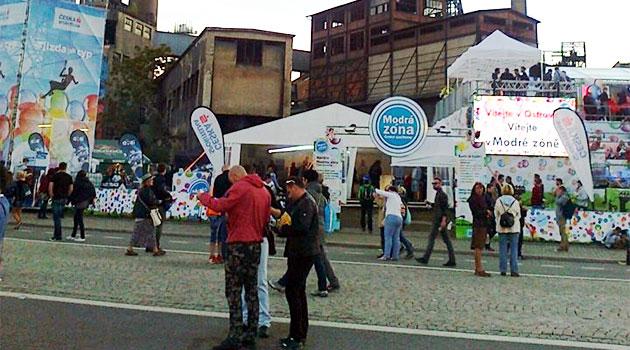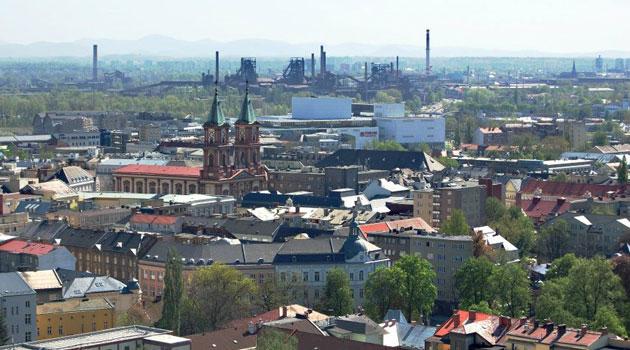Commentary: After you visit the music festival in Ostrava, take a look at the ghetto

It used to be called “Black Ostrava”. That was in the days when the motto was “We’re miners and we’re the best.”
Before 1989, such slogans were part of the daily massage of the Czechoslovak public delivered by Communist propaganda. Today, thanks to the “Colours of Ostrava” music festival, the city is now called “colorful Ostrava”, and the romanticized notions related to that festival are becoming part of a myth of an all-embracing, beautiful Ostrava – even though the city remains just as beautiful, and just as ugly, as it was in its youth.
Formerly Black Ostrava
Mills and mines have turned parts of northern Bohemia, Moravia and Silesia into a moonscape. These regions during the 1950s were characterized by high proportion of “shock workers” who exceeded their production plans by several hundred percent, and by the 1970s and 1980s their efforts resulted in an utterly devastated environment and a very low average life expectancy for local people.
Those efforts, however, created jobs for thousands of employees. The Communists hammered out iron and steel, ruthlessly destroying the air, human health, and the landscape, but it served a purpose because the mines and smelters brought people a livelihood and some social prestige – a professor at university might have been part of the “working intelligentsia”, but the ironworkers and miners were the elite (in those days).
It would never have occurred to anybody back then, of course, to call the chimneys, factory towers, ovens and other structures “beautiful”. Industrial architecture, in those days, was one of the symbols of our ruthlessness toward our own land, represented by the arrogance of communist power, and it looked just as monstrous, repulsive and rusty then as it does today.
The main thing is not to breathe
I’ve always liked Ostrava, on the whole. Part of my family comes from there – they lived in the Fifejdy quarter near the slag-heaps, where my ancestors
went to dig pieces of coal out of the coal-dust so there would be something to use for heat.
I first visiting Ostrava as a boy in 1970 (or perhaps 1971). What astounded me back then, among other things, was that “Black Ostrava” was much cleaner and tidier than (not-black) Prague.
People in Ostrava also had closer, friendlier relationships with each other than people did in the capital. As a native Praguer, I am understandably marked by the atmosphere of that metropolis, for better or for worse, and that’s why I know that the more people live in the same place (city), the greater the emotional distance between them.
The only thing one should never have done back in those days – not in Ostrava, and not in Prague either – was breathe. The air quality was horrendous, in many places it literally stank, with a “sulphurous” smell sometimes wafting through the streets, and not just near the smelters.
Even today, the air there is still not healthy – in some places it is precisely the opposite – but compared to conditoins then, it stinks less and breathing it is not as deadly as it used to be. The health of local people in Ostrava, however, is still being undermined by pollution.
Today’s Black Ostrava
Today Ostrava is “black” for a different reason. The ghettoes there are full of Romani people – except for those who have already fled the poverty and racism here for a civilized part of the world where they can mostly do well because they get an opportunity to apply their individual talents.
The pseudo-discussers on the Czech-language Internet have nicknamed the Roma “black trash”. These people are nauseated by their own frustration, and what we find raising its head once again among them are not just the usual psychological complexes, but nationalism and racism, the expression of contempt for others without addressing the causes of the situation and asking why there are increasing numbers of excluded localities, why the people who live there are mostly Romani, why they cannot break free of the symptoms of the so-called “culture of poverty”.
I personally know many Romani people in Ostrava, I have been friends with them for years, I’ve written about some of them, I know their fates and their stories, their ability to aid others even when they are in the greatest poverty themselves. Families stick together there in a way that others are unable to.
These are brilliant people. I frequently ask myself whether I would be able to maintain my own identity or personality in the conditions that they live in to the degree that most of them have managed to do so.
I admire these people, and not just for overcoming their circumstances. However, I also know that romanticized notions about Romani people are worthless, and that it is only with a full, thorough knowledge of such problems that situations can be addressed in order to benefit everybody.
Colorful Ostrava
The contemporary phenomenon of musical (and other) festivals can also be framed unromantically. The “Colours of Ostrava” festival, which after an initial phase of tyring to find the right venue now takes place in a closed part of the ironworks in the lower part of the Vítkovice quarter, is a good, partially commercialized festival that also focuses on serious topics.
Thanks to this focus, it attracts people who both want to have a good time and who also want to learn something. This year the atmosphere was a typical one for Ostrava – people were very friendly towards one another.
Experiences like this bear fruit. At the festival, in addition to listening to some boring, whiney Anglo-Saxon pop music, you could also submerge yourself in brilliant folk music – Congolese, Irish, Korean, Romani, Scottish – even if some of it does border on rock.
During a concert by a Mexican band an almost 70-year-old woman was jangling away next to me whose creativity and energy made the 20-year-olds present seem like frauds. The one and only act of sabotage was the Agrofert Stage (and not because of the music performed there, of course).
Most of the debates held at the festival about Europe and its current role in the world were moderated by commentator and translator Petruška Šustrová, who did a good job of summarizing what was said during them. Speaking to news server Romea.cz, Šustrová said “The first discussion on the topic of the problem of identity, the decline in values, and the influence of the demographic and migration crisis was very interesting. It was not framed in a populist way and involved an economist, a philosopher and a sociologist. The hall was absolutely full, around 400 people came. Václav Bělohradský was excellent. Jan Hartl announced fresh data from a poll showing that only 29 % of Czech citizens surveyed are in favor of European Union membership still.”
Other discussions about other current events were also held. All of discussions were organized by the PANT civic association, the online education portal Moderní-dějiny.cz (Modern History), and the Representation of the European Commission in Prague.
Extremism is what we should fear
Hundreds of people attended the bloc of debates about refugees over the two days of the festival. Czech Television reported on one discussion panel in detail, and those attending were able to learn things that the media does not otherwise much cover because they are not actually interested in reality, just in speculation and “reality shows”.
“I made an appearance on Czech Television recently. Later, when I read the online discussion that took place during the program, I discovered that people were most shocked by my blonde hair. They were asking how a Muslim dared have blonde hair,” said Samira Sibai, a doctor now working at Motol Hospital in Prague.
Dr Sibai’s mother is Czech and her father is Syrian. She left Syria in 2012 because of the war.
During her televised discussion, she repeated several times that we should fear extremism, not Islam. “I also am afraid of extremism. I am afraid of Islamist extremism just as I am afraid of European extremism. I am afraid of people from Islamic State just as I am afraid of the neo-Nazis. Our enemy is extremism in all its forms, not a certain religion, but extremism. We should combat it and combine our forces in the interest of preserving basic human dignity and freedom,” she told the packed hall of more than 300 people.
“Some people flee their countries sooner rather than later, but if they could return, the vast majority of them would. The people who come to Europe to work feel the same. If they could stay home and make money there, they would,” said Věra Roubalová, a Charter 77 signatory who provides psychotherapy to immigrants and refugees, during the discussion.
Black is a color too
It “rained a bit” on the festival, as somebody euphemistically described the forceful tropical showers that swept over Ostrava during those days. However, even that was something to be amazed by.
“I don’t think I ever experienced something like that even in India,” said Kumar Vishwanathan, our friend of many years who leads the Life Together (Vzájemné soužití) association in Ostrava, about the amount of water rapidly drifting down from the skies. Not even the “Colours of Ostrava”, though, was able to change a former factory with all of its depressing industrial “architecture” into a Gothic quarter.
All of the beautiful festival colors can’t cover up the black reality of Ostrava, nestled on the outskirts of society in the ghettos, living in incredible humiliation and misery. We can have a good time, learn something new… but let’s not forget, please, to take a look next time at the places where, without any romanticism, the poorest of the poor are living, because we can learn a great deal about ourselves there, too.
